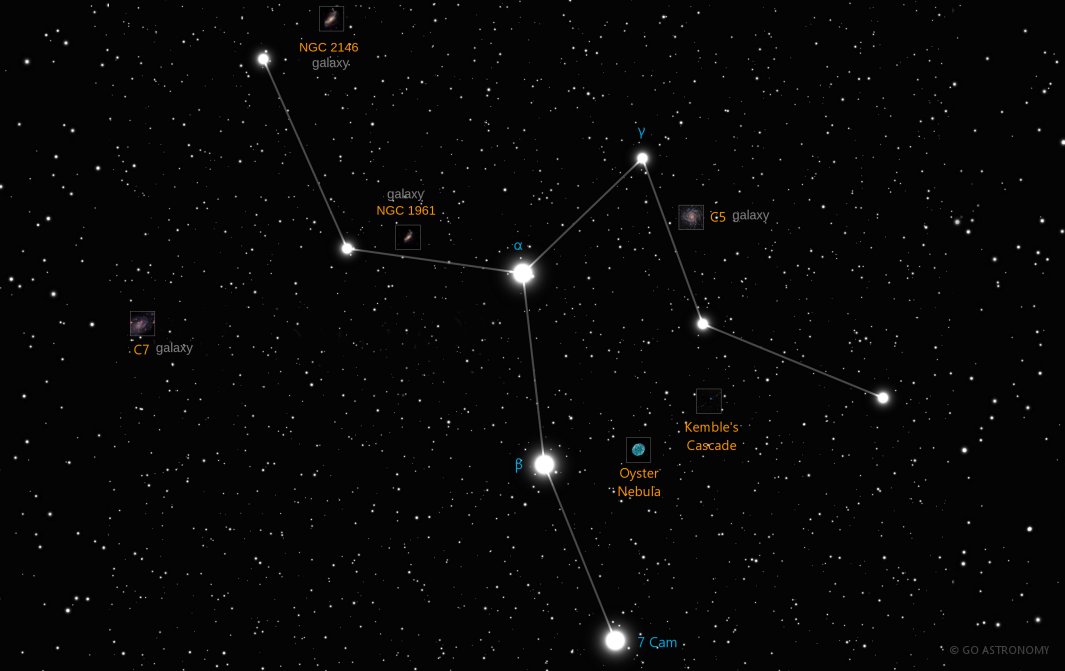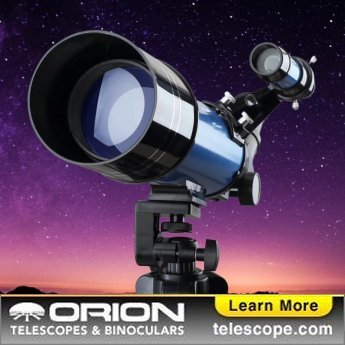Camelopardalis, the Giraffe (Cam)
(camel-oh- PAR-duh-liss)
The Northern constellation of Camelopardalis, the Giraffe, is best viewed in Winter during the month of February.
Camelopardalis is the 18th largest constellation. It's brightest star is Beta Cam at magnitude 4.03. The boundary of the Camelopardalis constellation contains 7 stars that host known exoplanets.
Camelopardalis is a circumpolar constellation, so is visible year-round in the Northern hemisphere. Conversely, it is not visible in the opposite hemisphere.
- Pronunciation:
- camel-oh- PAR-duh-liss
- Meaning:
- Giraffe
- Genitive:
- Camelopardalis
- Abbreviation:
- Cam
- Constellation Family:
- Ursa Major
- Hemisphere:
- Northern
- Quadrant:
- NQ2
- Visibility:
- 90° N - 10° S
- Best viewing month*:
- February
- Area:
- 757 sq. degrees
- Size:
- 18th largest
- Circumpolar** (N=northern, S=southern):
- N circumpolar
- Right Ascension (avg):
- 6h 9m
- Declination (avg):
- 69°
- Brightest star:
- Beta Cam (4.03)
- Stars with planets:
- 7
- Messier objects:
- |
Brightest Stars in Camelopardalis
The 10 brightest stars in the constellation Camelopardalis by magnitude.
- Star
- Magnitude
- Spectral class
- Beta Camelopardalis (β Cam)
- 4.03
- G0Ib
- CS Camelopardalis (CS Cam)
- 4.21
- B9Ia
- Alpha Camelopardalis (α Cam)
- 4.26
- O9.5Ia SB
- BE Camelopardalis (BE Cam)
- 4.39
- M1III
- 7 Camelopardalis (7 Cam)
- 4.43
- A1V
- CE Camelopardalis (CE Cam)
- 4.55
- A0Ia SB
- HD 49878
- 4.55
- K4III
- Gamma Camelopardalis (γ Cam)
- 4.59
- A2IVn
- BK Camelopardalis (BK Cam)
- 4.74
- B2.5Vne
- HD 42818
- 4.76
- A0Vn
Double Stars in Camelopardalis
These are the brightest and easiest-to-find double, triple, and quadruple star systems in the constellation Camelopardalis. Also see all star clusters.
- Star system
- Magnitudes
- Type
- 1 Camelopardalis
- 5.8, 6.8
- double
- 32 Camelopardalis
- 5.3, 5.7
- double
Star Clusters in Camelopardalis
The most notable and easy-to-find star clusters in the constellation Camelopardalis . Also see all star clusters.
Nebulae in Camelopardalis
Notable and easy-to-find nebulae in the constellation Camelopardalis . Also see all nebulae.
Galaxies in Camelopardalis
The most notable galaxies in the constellation Camelopardalis. Also see all galaxies.
- Name
- Alt name
- Type
- Integral Sign Galaxy
- spiral
- Caldwell 7
- C7
- spiral
- Hidden Galaxy
- C5
- spiral
- NGC 1569
- starburst
- NGC 2146
- starburst
Neutron Stars in Camelopardalis
These are the most well-known neutron stars in the constellation Camelopardalis. Although neutron stars cannot be seen in any amateur telescope, they are at the center of many supernova remnant nebulae, which can be seen. Also see all neutron stars.
The Celestial Giraffe
Camelopardalis, commonly referred to as the "Celestial Giraffe," is a constellation in the Northern Hemisphere, notable for its vast size and intriguing deep-sky objects. Its name, derived from the Greek word "kam?lopardalis," translates to "giraffe," though its stars don't form a pattern that distinctly resembles the animal. The constellation offers an interesting mix of celestial objects for observers and astronomers alike.
Historical Background
Camelopardalis is not associated with any particular myth or legend, unlike many other constellations. It was first cataloged by the Dutch astronomer Petrus Plancius in the late 16th century and later included in Johann Bayer's star atlas Uranometria in 1603. It is one of the relatively modern constellations introduced as the night sky was more thoroughly mapped and documented.
Location and Notable Features
Camelopardalis is located in the second quadrant of the Northern Hemisphere (NQ2), covering an impressive 757 square degrees. It lies in a region surrounded by notable constellations, including Ursa Major, Draco, Cassiopeia, and Perseus. This sprawling constellation contains no particularly bright stars; its brightest star, Beta Camelopardalis, only has an apparent magnitude of 4.03. Nonetheless, what it lacks in brightness, it makes up for in size, as it is the 18th largest constellation in the sky.
Deep Sky Objects
Despite its faint stars, Camelopardalis is home to several notable deep-sky objects that can captivate astronomers. Among them is NGC 2403, an intermediate spiral galaxy. Discovered by William Herschel in 1788, NGC 2403 has an apparent magnitude of 8.9 and is a part of the M81 Group of galaxies. This galaxy contains an abundance of H II regions, where active star formation is taking place, and several supernovae have been observed in this galaxy over the years.
Another intriguing object in Camelopardalis is the Kemble's Cascade asterism. Named after the amateur astronomer Father Lucian Kemble, this striking linear arrangement of stars appears like a celestial waterfall, stretching over five moon diameters in the sky, and culminates in the open cluster NGC 1502.
Observing Camelopardalis
Camelopardalis is best observed during the months of January to March. Given its northerly location, it is visible throughout the year for observers in the Northern Hemisphere. However, due to its dim stars, it is best observed from a dark-sky location. Binoculars or a small telescope would enhance views of its deep-sky objects, like NGC 2403 and Kemble's Cascade.
Despite its low brightness, the charm of Camelopardalis lies in its deep-sky offerings. Its relative obscurity may also appeal to stargazers who are looking for a less-trodden path across the celestial sphere.
* Constellation shown for northen hemisphere skies. For the southern hemisphere, constellations appear rotated 180 degrees (upside-down and left-right reversed) from what is shown. Remember that seasons are reversed too - summer in northern latitudes is winter in southern latitudes.
** Circumpolar constellations are visible year-round in the hemisphere listed (and not at all in the opposite hemisphere).





